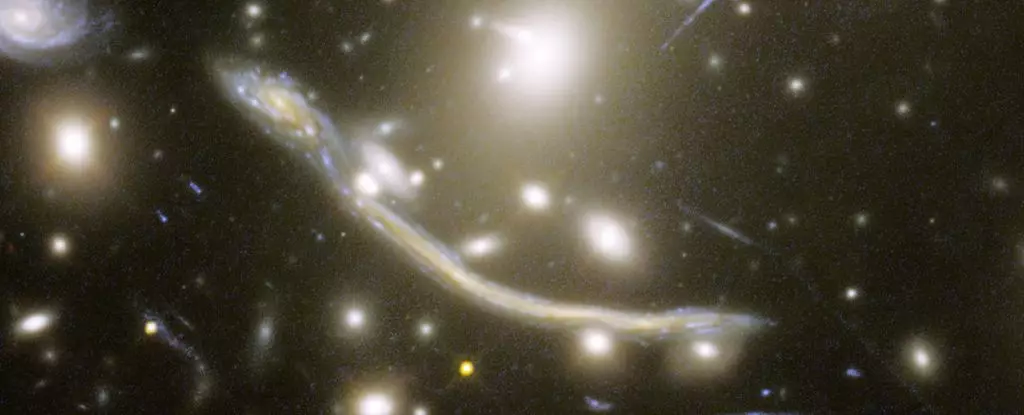The vastness of the cosmos often obscures our understanding of its origins and the myriad of celestial bodies it houses. The early Universe, a realm obscured by time and distance, presents a formidable challenge for astronomers seeking to penetrate its mysteries. While light from galaxies billions of light-years away is nearly beyond the grasp of our instruments, recent advancements have transformed our observational capabilities. By employing the James Webb Space Telescope (JWST), scientists have recently made a remarkable breakthrough: they have successfully isolated over 40 individual stars from a distant galaxy, overcoming the previous limitations set by earlier technologies like the Hubble Space Telescope.
Astrophysicist Fengwu Sun from the University of Arizona provided insight into the significance of this discovery: “This groundbreaking discovery demonstrates, for the first time, that studying large numbers of individual stars in a distant galaxy is possible.” Previously, the Hubble Space Telescope had only managed to identify around seven stars in such hostile observational conditions. With JWST’s sophisticated technology, we are now able to dissect the celestial tapestry and unlock details that were once considered unattainable, paving the way for a deeper understanding of the universe.
One of the key implications of resolving individual stars in such distant galaxies is the potential it opens for studying dark matter. With a higher number of observable stars, researchers will be better equipped to probe lensing models—crucial for understanding the intricate web of dark matter that shapes our universe in ways we are only beginning to comprehend.
The Role of Gravitational Lensing
Astronomical observations can be extraordinarily complex, but they are often made clearer through the phenomenon of gravitational lensing. This effect occurs when light from a distant star or galaxy passes through the gravitational field of a massive object, such as a galaxy cluster. This warps the space around it, creating a lensing effect that can magnify and sometimes duplicate the image of the distant object. The Dragon Arc, a captivating visual reminiscent of a Chinese dragon, serves as an exceptional example of this phenomenon, featuring images of a spiral galaxy stretched across the sky.
The massive cluster of galaxies known as Abell 370, located four billion light-years away, is responsible for this stunning display. The complexities of this lensing effect allow astronomers to indirectly observe galaxies that would otherwise be lost in the expansive darkness of the universe. More impressively, once the distortions caused by gravitational lensing are accounted for, scientists can reconstruct what these distant celestial bodies would look like under normal circumstances, offering a never-before-seen perspective on ancient galaxies.
While gravitational lensing has been a recognized mechanism for observing distant objects, the recent accomplishments hinge on another fascinating effect known as microlensing. This occurs when isolated stars within a galaxy cluster also contribute their gravitational pull, further enhancing the lensing effect and allowing astronomers to detect individual stars that could be obscured by light from more massive bodies.
A distinguished team of researchers, spearheaded by Yoshinobu Fudamoto from Chiba University in Japan, utilized this microlensing approach to reveal 44 individual stars within the Dragon Arc. This achievement stands as a testament to the innovative methodologies being employed in modern astronomy. “When we discovered these individual stars, we were actually looking for a background galaxy,” says Sun. The sheer excitement of realizing the visibility of these far-flung stars not only transforms our understanding of this region but reaffirms the potential of space exploration and discovery.
The newfound visibility of individual stars also offers unique insights into the life cycles of these distant celestial bodies. Among the stars observed in the Dragon Arc, many exhibit characteristics of red supergiants—massive stars nearing the end of their life cycles that have expanded significantly after exhausting their nuclear fuel. This is significant since these stars are cooler than the luminous blue and white giants typically observed at such vast distances.
The JWST’s capability to detect longer wavelengths of light has been crucial in identifying these red supergiants that elude the gaze of other instruments. As more data continues to flow in from JWST’s observations, astronomers are optimistic that we will uncover even more stars nestled within the dim, blurry light of the Dragon Arc, enhancing our understanding of stellar evolution in distant galaxies.
The contributions of JWST to our understanding of the early Universe are vast and varied. As it continues to survey the cosmos, the potential for groundbreaking discoveries remains boundless. The ability to resolve individual stars across extraordinary distances not only enhances our comprehension of the formation and evolution of galaxies but sheds light on the elusive nature of dark matter and the mechanics governing cosmic growth and decay.
The advancements brought about by the JWST signal a new era in astronomy, one where we can more accurately map the cosmos and grapple with essential questions about our place within it. As we look toward future explorations, the whispers of the universe from billions of light-years away become clearer, inviting us to unlock more of its profound secrets.


Leave a Reply